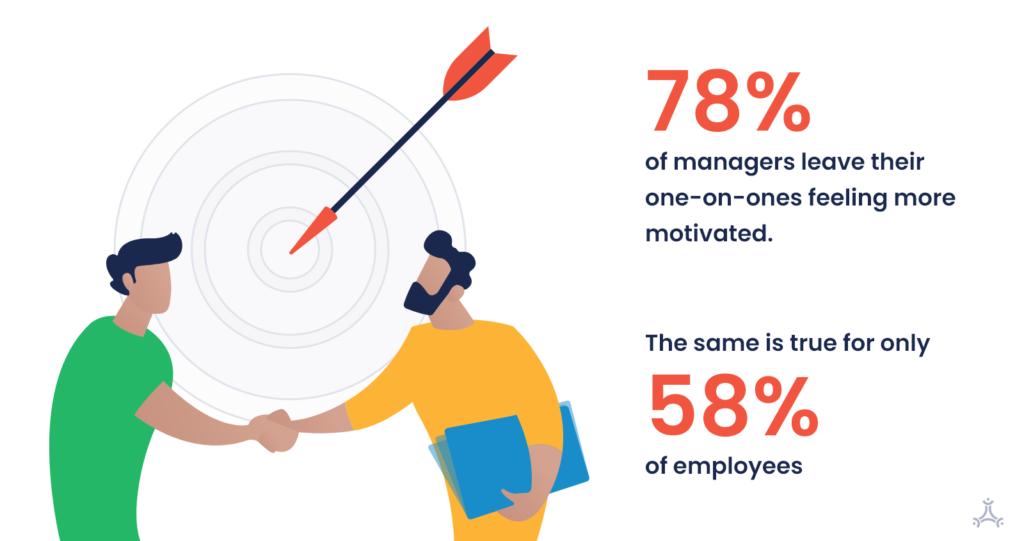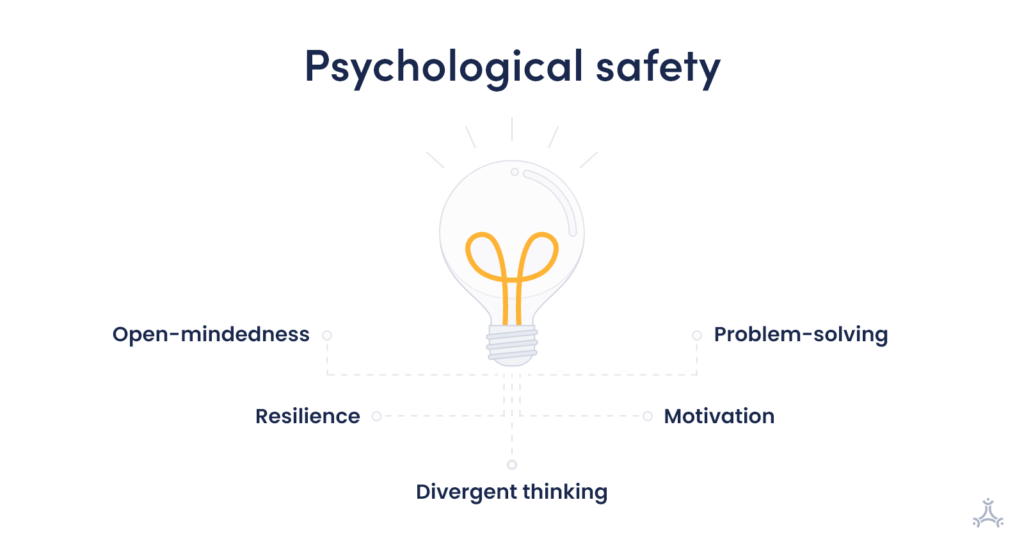Effective one-on-one meetings are the cornerstone of a good manager and employee relationship. Learn how to run effective meetings with these seven tips that will boost your management strategy.
You may be at your wit's end trying to figure out the best way to run effective one-on-one meetings.
Whether this is your first time leading teams or are looking to up your game, here are my top 7 tips that can transform a dull and pointless one-on-one into a productive and empowering discussion.
7 Tips for Making Your One-on-Ones Super Effective
Let me say this straight:
There isn't one universal model that's best for all individuals when it comes to running effective one-on-one meetings.
Instead, every meeting should be tailored to each individual's needs.
For example, meetings with a junior Laravel engineer should differ from meetings with a senior Laravel engineer.
Why is that?
Well, a junior engineer may need more help with adjusting to your company culture, while a senior engineer may require guidance on how to progress to a managerial position.
With this in mind, it's time for me to share a few general guidelines that can ensure your one-on-ones are going smoothly and your engineers are not staring into blank space.

Start the Meeting by Sharing a Win
Here's an interesting story:
When HBR researchers explored creative work inside businesses, they stumbled upon a remarkable phenomenon.
They analyzed diaries kept by knowledge workers and discovered a significant progress principle. They concluded that the most critical thing that can boost motivation during a workday is making progress in meaningful work.
In other words, the more often people experience a sense of progress, the more likely they are to be creatively productive in the long term.
Whether it's someone working on a scientific breakthrough project or building a tech product, even the smallest win can make a difference in how employees feel and perform.
Here's what one programmer said to HBR researchers after a productive day:
I smashed that bug that’s been frustrating me for almost a calendar week. That may not be an event to you, but I live a very drab life, so I’m all hyped.
This somewhat extensive explanation takes me to my first tip for running effective one-on-one meetings:
Start your meetings by sharing a win.
It doesn't have to be a large win; it can be something as small as complementing the engineer on the latest functionality they built.
Unfortunately, there's a negative side as well.
It turns out that negative events can have an even more powerful impact than positive ones on an employee's motivation for work.
With this in mind, managers should do their best to minimize daily hassles that can negatively affect a person's motivation.
Create a Psychologically Safe Environment to Help Them Open up
In 2015, Google’s People Operations department set out to answer the question What makes a Google team effective?
They discovered that five fundamental dynamics make the difference between successful and unsuccessful teams.
According to their study, one of the most critical dynamics turned out to be psychological safety.
In short, psychological safety means that team members feel safe to be vulnerable in front of each other. The study found that teams with higher psychological safety:
- are more effective
- bring in more revenue
- are less likely to leave the company
- are more likely to harness the power of diverse ideas from their teammates
Think about it.
Psychological safety makes people become more open-minded, motivated, and resilient. Their sense of humor also increases, as well as their problem-solving and divergent thinking abilities.
My tip #2 for effective one-on-one meetings is this: create a psychologically safe environment by encouraging the employee to open up.
The best way of doing so is first to open up yourself.
For example, share a story about something you did wrong at work and how that affected your mood that day. By demonstrating vulnerability, you're actually telling the employee that it’s OK to make mistakes.
Another idea is to start every meeting by breaking the ice. Icebreaker questions are fantastic conversation starters. As cheesy as they may sound, they can do a fine job making the meeting environment more relaxed and safe.
For example, you can ask them:
- What is one item you couldn’t live without?
- What quirky thing do you do regularly?
- What’s your unusual talent?
- Where would you go once the pandemic ends?
Once you have the conversation going, continue by asking some of the following questions:
- What would you like us to discuss today?
- Are there any roadblocks preventing you from completing your tasks?
- How do you think we should structure our meetings?
- Is there anything specific you'd like to discuss with me today?
I try to build a good rapport with my direct reports. Sometimes this is sharing an interesting/funny story about something that happened while I was in their position, or illustrating a specific challenges I had that I believe everyone faces. I also have several resources on hand to fall back on to get them to open up better.
James Carr, Infrastructure Engineering Lead at Zapier

Create a Shared One-on-One Meeting Agenda
Don't you just hate it when you go into a meeting and the discussion seems to be all over the place? You jump from one topic to the next without any insightful discussion or action plan.
I've been there.
Over the years, I've discovered that there are multiple benefits to having a clear structure for your meetings.
Knowing what will be discussed during a meeting helps my employees prepare and ensures the discussion doesn't go off the rails.
My third tip for effective one-on-one meetings is to set a few recurring themes that you will discuss in your meetings.
For example, you can be talking about projects you completed in the previous week and priority tasks that should be completed in the week. You can discuss issues, roadblocks, and action items.
Keep in mind that your direct report should own the overall agenda of the meeting.
Ask them what they want to see added to the agenda. The agenda should reflect their needs—that is, if you care about employee engagement.
Ask them to suggest agenda items and the reason why they want to see those items included. In case you decide not to include something they suggested, don't forget to offer an explanation.
Here's a rough sum up of what the meeting agenda can include:
- Discuss this week
- Revisit later
- Roadblocks and wins
- Goals
- Action items
Adding a bit of flexibility to your meetings is also recommended.
Once a month, change the agenda for the meeting. Use the time you have to talk about the engineer's growth and career development plan or listen to their constructive feedback.
Here are a few more ideas on what you could discuss in your meetings:
- Feedback on any in-progress assignments.
- Checking in on company goals.
- Identifying and resolving any roadblocks.
- Celebrating milestones.
- What worked well and what not on recent projects.
Keep in mind that a structure that works for one direct report may not work for another. Find a process and structure that works best for each employee.
Don't forget to type in the meeting agenda when you schedule the recurring meetings so that your attendee can easily reference it.
Another idea is to write the meeting agenda in Google docs and include the URL in the meeting description box so that you both have easy access when the time for the meeting comes around.
If Asana is your go-to tool for everything from sharing files to checking up with employees, here's a step-by-step guide on how to create a one-on-one project on the platform.
Now that I'm using Asana, my conversations and 1:1s are so much more productive because we have this shared space where we can collaborate.
Tim Wood, Head of Product, Patreon
The Length and Frequency Can Vary for Each Employee
The fact is that 30-minute weekly one-on-ones are the most common choice for engineers and their managers.
However, this doesn't mean that you should adopt the same model.
The length and frequency of your one-on-one meetings should differ with each employee.
For example, meetings with your team leader may occur more frequently and last longer as you may have plenty of things to discuss, ranging from issues with team members to software development roadblocks.
When deciding on the length and frequency of your one-on-ones, here are some things you need to consider:
- Is the engineer a newly employed employee, or have they been a part of the company for a while?
- Is the engineer a team leader?
- Do you have a lot to discuss every week?
- Are you guiding the employee towards becoming a tech leader?
- Do you have something urgent to discuss with your report each week?
If we look at what studies and reports show, employees who have regular meetings with their managers are almost three times more likely to be engaged than employees who don't have regular meetings with their managers.
But hear this: the fact that one-on-ones happen at all is more important to employees than the frequency of meetings.
My tip would be to experiment with frequency until you find the right rhythm.
If you have nothing to discuss this week, and the engineer feels the same, you can just cancel the one-on-one. This is completely normal, and it happens all the time.
I'd rather have my employee work on an urgent task than spend 30 minutes in a meeting that's pointless.
As a software developer, avoiding meetings is generally a good call because they interrupt flow and often don’t really need you to be there, and meetings aren’t really getting work done. One of the weirdest things about becoming a manager is how much more meaningful meetings seem to become, and how many more of them appear on the calendar.
Chris Kelly, Former Senior Manager, Software Engineering at Salesforce
Take Action on Your Engineer's Feedback
Let's imagine the following scenario:
Your Shopify developer shares feedback with you during one of your meetings. They say the development team is understaffed and needs to add a few more software engineers.
Do you take action?
Here's the thing:
Whether you agree or disagree with the feedback, a better strategy is to acknowledge it than to ignore it.
For example, saying something like, “Let me think about it and I'll get back to you next week," can greatly improve the employee's motivation and engagement.
Take some time to think about the employee's feedback and discuss it over the course of your next meeting.
How do I know?—From personal experience and reading various studies.
For instance, one study conducted by John Izzo—an author, speaker, and advisor on corporate sustainability issues—found that a big factor in preventing employees from speaking up is how leaders react to their ideas and input.
A whopping 38% of respondents said that "leaders dismissing ideas without exploring these ideas" is why they don't take initiative.
Another 26% said that "not getting rewarded or recognized for playing outside the lines" is another major factor why they don't step up.
The biggest problem for people was "leaders making decisions without seeking input."
So, what does this all mean?
It means that if you expect employees to take initiative and bring forth ideas, you have to build a company culture that values ideas.
In fact, building a company culture that values people's ideas can lead to an improvement in so many areas of your company, such as employee productivity, engagement, retention, and innovation.

Include Different Topics in Your Meetings
Let's be real:
Very often, one-on-one meetings turn into simple status updates—nothing more, nothing less.
In fact, 54% of managers said that one of the main goals of these meetings was to ask how specific projects are coming along.
Don't get me wrong.
I'm not trying to say that you shouldn't prioritize pressing issues and those of strategic importance.
What I'm saying is that you should include different topics in your meetings.
For instance, one-on-ones are an ideal opportunity to discuss an employee's growth and development. So, why not use the meeting to be curious about their plans for the future?
It's up to you, but when I plan on discussing growth and development with an engineer, I let them know beforehand. As these meetings usually require reflection and thought, I give my reports the time and space to think about what they want to say.
Here are a few questions I often ask my direct reports:
- Are you interested in developing additional skills?
- What do you love most and least about your job?
- What projects have you enjoyed working on recently?
- Would you like to be part of different projects?
- Would you benefit from more mentoring?
One-on-ones can also be a place where the employee can open up about problems and challenges they're facing.
Some things to ask your report include:
- What changes could be made to help your productivity?
- What are your most time-consuming tasks right now?
- Are you encountering any roadblocks?
Also, don't hesitate to ask for their feedback.
Here are a few questions to ask:
- Do you find these meetings helpful?
- Do you feel empowered in your role?
- What can I change to help you work more efficiently?
If you are not careful, 1:1s can end up being status updates. Or the manager can take over the meeting. This isn’t their purpose. It’s important to make sure the employee and their needs stay front-and-center.
Bronwyn Smith, VP of Business Operations at Influitive
End the Meeting on a Positive Note
Let's get to the final tip for effective one-on-one meetings:
You want to end the meeting in a similar way as you began it—with positive things.
If the best way to start an effective one-on-one meeting is to share a small win, the ideal way to end it is to show your appreciation and gratitude.
Don't worry. I'm not saying you should recite an Oscar speech, thanking your direct report for all of their hard work and dedication until you hear the play-off music.
Say something like, "Thank you for your time. Keep up the good work."
It's short, it's clear, it's powerful.
Final Conclusion: Do's and Don'ts
Congrats! You made it to the end of this extensive post.
Hopefully, you found it insightful and discovered a few great strategies for effective one-on-one meetings.
To sum up, this long post boils down to these do's and don'ts.
Do's:
- Tailor your meeting to each unique individual.
- Start your meetings by sharing a win.
- Create a psychologically safe environment by demonstrating your vulnerabilities.
- Have a structure for your meetings.
- Add a bit of flexibility to your meetings.
- Experiment with frequency until you find the right rhythm.
- Acknowledge your employee's feedback.
- Discuss different topics.
- End the meeting on a positive note.
Don'ts:
- Avoid making the meeting about yourself.
- Don't let the meeting turn into a simple status update.
- Don't hesitate to skip a meeting if there's nothing to discuss.
- Make sure not to dismiss your employee's ideas without an open discussion.
The most important lesson in entrepreneurship: Embrace the struggle.
Ben Horowitz, The Hard Thing About Hard Things


